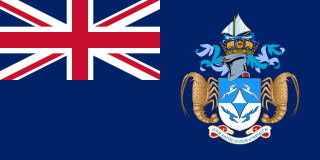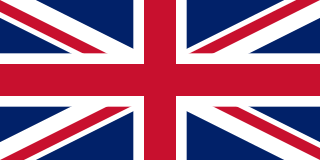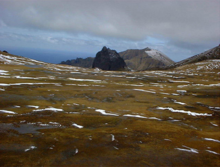
Saint Helena is an island in the South Atlantic Ocean, about midway between South America and Africa. St Helena has a land area of 122 square kilometres and is part of the territory of Saint Helena, Ascension and Tristan da Cunha which includes Ascension Island and the island group of Tristan da Cunha.
Saint Helena, Ascension and Tristan da Cunha are British Overseas Territories in the south Atlantic Ocean.

Tristan da Cunha, colloquially Tristan, is a remote group of volcanic islands in the South Atlantic Ocean. It is the most remote inhabited archipelago in the world, lying approximately 2,787 kilometres (1,732 mi) from Cape Town in South Africa, 2,437 kilometres (1,514 mi) from Saint Helena, 3,949 kilometres (2,454 mi) from Mar del Plata in Argentina, and 4,002 kilometres (2,487 mi) from the Falkland Islands.

Gough Island, also known historically as Gonçalo Álvares, is a rugged volcanic island in the South Atlantic Ocean. It is a dependency of Tristan da Cunha and part of the British overseas territory of Saint Helena, Ascension and Tristan da Cunha. It is approximately 400 km (250 mi) south-east of the Tristan da Cunha archipelago, 2,400 km (1,500 mi) north-east from South Georgia Island, 2,700 km (1,700 mi) west from Cape Town, and over 3,200 km (2,000 mi) from the nearest point of South America.

Inaccessible Island is a volcanic island located in the South Atlantic Ocean, 31 km (19 mi) south-west of Tristan da Cunha. Its highest point, Swale's Fell, reaches 581 m (1,906 ft), and the island is 12.65 km2 (4.88 sq mi) in area. The volcano was last active approximately one million years ago and is now extinct.

Nightingale Island is an active volcanic island in the South Atlantic Ocean, 3 square kilometres (1.2 sq mi) in area, part of the Tristan da Cunha group of islands. They are administered by the United Kingdom as part of the overseas territory of Saint Helena, Ascension and Tristan da Cunha.

The Nightingale Islands are a group of three islands in the South Atlantic Ocean, part of the Tristan da Cunha territory. They consist of Nightingale Island, Middle Island and Stoltenhoff Island. The islands are administered by the United Kingdom as part of the overseas territory of Saint Helena, Ascension and Tristan da Cunha. The Nightingale Islands are uninhabited.

Middle Island is a small, uninhabited island in the South Atlantic Ocean, part of the Nightingale Islands. It is governed as part of Tristan da Cunha, an archipelago that is part of the British overseas territory of Saint Helena, Ascension and Tristan da Cunha. The island is part of the Nightingale Islands group Important Bird Area (IBA), identified as such by BirdLife International as a breeding site for seabirds and endemic landbirds. It is also known as Alex Island.

Stoltenhoff Island is a small uninhabited island in the South Atlantic Ocean, part of the Nightingale Islands. It is the smallest of the Nightingale Islands, and is to the northwest of Nightingale Island itself. They are governed as part of Tristan da Cunha, an archipelago and part of the British overseas territory of Saint Helena, Ascension and Tristan da Cunha. The island is part of the Nightingale Islands group Important Bird Area (IBA), identified as such by BirdLife International as a breeding site for seabirds and endemic landbirds.
Saint Helena, Ascension Island and Tristan da Cunha, as well the other uninhabited islands nearby, are a haven for wildlife in the middle of the Atlantic Ocean. The islands are or were home to much endemic flora and fauna, especially invertebrates, and many endemic fish species are found in the reef ecosystems off the islands. The islands have been identified by BirdLife International as Important Bird Areas for both their endemic landbirds and breeding seabirds.

The Gough finch or Gough bunting, is a critically endangered species of songbird.

The following outline is provided as an overview of and topical guide to Ascension Island:

The following outline is provided as an overview of and topical guide to Saint Helena:

The following outline is provided as an overview of and topical guide to Tristan da Cunha:

Ascension Island is an isolated volcanic island, 7°56′ south of the Equator in the South Atlantic Ocean. It is about 1,000 miles (1,600 km) from the coast of Africa and 1,400 miles (2,300 km) from the coast of South America. It is governed as part of the British Overseas Territory of Saint Helena, Ascension and Tristan da Cunha, of which the main island, Saint Helena, is around 800 miles (1,300 km) to the southeast. The territory also includes the sparsely populated Tristan da Cunha archipelago, 2,300 miles (3,700 km) to the south, about halfway to the Antarctic Circle.

Saint Helena, Ascension and Tristan da Cunha is a British Overseas Territory located in the South Atlantic and consisting of the island of Saint Helena, Ascension Island, and the archipelago of Tristan da Cunha. Its name was Saint Helena and Dependencies until 1 September 2009, when a new constitution came into force, giving the three islands equal status as three territories, with a grouping under the Crown.
The islands of Africa are a major geographical sub-region of Africa, and represent a distinct demographic and historical cultural sphere of influence on the continent.
Edinburgh Peak is the highest mountain in Gough Island, South Atlantic Ocean.

The Tristan da Cunha–Gough Islands shrub and grasslands is a terrestrial ecoregion which covers the Tristan da Cunha archipelago and Gough Island in the South Atlantic Ocean. The islands' remote location gave rise to many endemic species.













